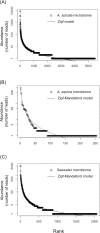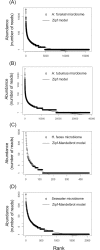Diversity and antimicrobial potential in sea anemone and holothurian microbiomes
- PMID: 29742123
- PMCID: PMC5942802
- DOI: 10.1371/journal.pone.0196178
Diversity and antimicrobial potential in sea anemone and holothurian microbiomes
Abstract
Marine invertebrates, as holobionts, contain symbiotic bacteria that coevolve and develop antimicrobial substances. These symbiotic bacteria are an underexplored source of new bioactive molecules to face the emerging antibiotic resistance in pathogens. Here, we explored the antimicrobial activity of bacteria retrieved from the microbiota of two sea anemones (Anemonia sulcata, Actinia equina) and two holothurians (Holothuria tubulosa, Holothuria forskali). We tested the antimicrobial activity of the isolated bacteria against pathogens with interest for human health, agriculture and aquaculture. We isolated 27 strains with antibacterial activity and 12 of these isolates also showed antifungal activity. We taxonomically identified these strains being Bacillus and Vibrio species the most representative producers of antimicrobial substances. Microbiome species composition of the two sea anemones was similar between them but differed substantially of seawater bacteria. In contrast, microbiome species composition of the two holothurian species was different between them and in comparison with the bacteria in holothurian feces and seawater. In all the holobiont microbiomes Bacteroidetes was the predominant phylum. For each microbiome, we determined diversity and the rank-abundance dominance using five fitted models (null, pre-emption, log-Normal, Zipf and Zipf-Mandelbrot). The models with less evenness (i.e. Zipf and Zipf-Mandelblot) showed the best fits in all the microbiomes. Finally, we tracked (using the V4 hypervariable region of 16S rRNA gene) the relative abundance of these 27 isolates with antibacterial activity in the total pool of sequences obtained for the microbiome of each holobiont. Coincidences, although with extremely low frequencies, were detected only in the microbiome of H. forskali. This fact suggests that these isolated bacteria belong to the long tail of rare symbiotic bacteria. Therefore, more and more sophisticated culture techniques are necessary to explore this apparently vast pool of rare symbiontic bacteria and to determine their biotechnological potentiality.
Conflict of interest statement
Figures




References
-
- Ling LL, Schneider T, Peoples AJ, Spoering AL, Engels I, Conlon BP, et al. A new antibiotic kills pathogens without detectable resistance. Nature. 2015. January 22;517(7535):455–9. doi: 10.1038/nature14098 - DOI - PMC - PubMed
-
- Montesinos E. Development, registration and commercialization of microbial pesticides for plant protection. Int Microbiol Off J Span Soc Microbiol. 2003. December;6(4):245–52. - PubMed
-
- Bostock J, McAndrew B, Richards R, Jauncey K, Telfer T, Lorenzen K, et al. Aquaculture: global status and trends. Philos Trans R Soc Lond B Biol Sci. 2010. September 27;365(1554):2897–912. doi: 10.1098/rstb.2010.0170 - DOI - PMC - PubMed
-
- Subasinghe R, Bondad-Reantaso M, McGladdery S, Bueno P, Phillips M, Hough C, et al. Aquaculture development, health and wealth Network of Aquaculture Centres in Asia-Pacific, Bangkok (Thailand); FAO, Rome (Italy). Fisheries Dept., editor. FAO NACA. 2001;167–92.
-
- Cabello FC. Heavy use of prophylactic antibiotics in aquaculture: a growing problem for human and animal health and for the environment. Environ Microbiol. 2006. July 1;8(7):1137–44. doi: 10.1111/j.1462-2920.2006.01054.x - DOI - PubMed
Publication types
MeSH terms
LinkOut - more resources
Full Text Sources
Other Literature Sources
Molecular Biology Databases
Miscellaneous

